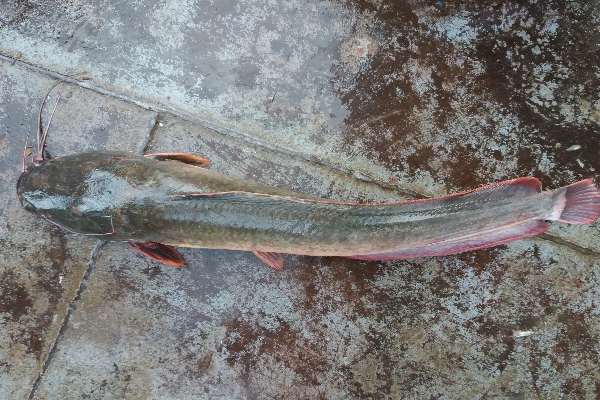Common names:
North African catfish; Sharptooth catfish
Lunyoro/Luruli/Lunyara/Lukenyi: Mali Ludope: Nyaki Lango: Twang Central Uganda: Male
Taxonomic tree
Kingdom: Animalia
Phylum: Chordata
Class: Actinopterygii (ray-finned fish)
Order: Siluriformes (Catfishes)
Family: Clariidae (Airbreathing catfishes)
Genus: Clarias
Species: Clarias gariepinus (Burchell, 1822)
Number of Occurrancies: 781
Etymology (based on Sharpf & Lazara, 2019)
- Clarias: From Greek word chlaros (note that Scopoli’s spelling was Chlarias), meaning lively, referring to the extreme hardiness of clariids and/or their ability to live for a long time out of water (and, in some cases, actually move across land).
- gariepinus: -inus, in connection with the type locality, Gariep (meaning “Great Water” according Khoikhoi people) River (now known as Orange River), the longest river in South Africa.
Synonyms: click here to view synonyms
Type locality: Vaal River, at Smidtsdrift, above confluence with Riet River, South Africa. Neotype at South African Institute for Aquatic Biodiversity (SAIAB).
Distinguishing characters for the genus
- Flat and broad, usually bony, head (especially behind the eyes); upper surface coarsely granulated in adults and smooth in young fishes (Clariallabes have soft sides of the head)
- Scaleless, elongate, body with small eyes and no adipose fin
- Long dorsal fin, with no spine, extending from slightly behind the head to the caudal fin, from which it is narrowly separated
- Long anal fin, extending to, or almost to the caudal fin base than to the snout
- Air breathing organs derived from the 2nd and 4th epibranchials within the superbranchial chamber (Xenoclarias lack this organ)
- Dorsal and anal fin distinct from the caudal fin (Clariallabes have confluent dorsal, anal and caudal fins)
Distinguishing characters for the species
- Maxillary barbel rarely shorter than the head, usually longer and reaching a point mid way between the origin of the dorsal fin and the insertion of the pelvic fin
- Pelvic fin bases about midway between the tip of the snout and the origin of the anal fin, or slightly nearer the snout
- A robust pectoral fin spine that is only serrated on its outer side
- Gill rakers long, fine and closely set, varying from 24-110, the number increasing with fish size
- Colour is variable and appear to correlate with water turbidity and substrate type. Generally dark greyish-black dorsally, creamy ventrally. Fishes in clear open waters are always very lightly coloured
Distribution in Uganda: Widely distributed across the country's water bodies. Known in all major lakes (Victoria, Kyoga, Edward, Albert and George) and affluent rivers, minor lakes, small streams and swamps associated with major rivers and lakes.
Occurence: Native
Habitat: Benthpelagic, inhabiting waters just above the muddy bottom. In small and shallow systems, the fish is ubiquitous, but in large lakes, its habitat is largely associated with shallow inshore regions, especially in marginal water-lily and papyrus swamps. Potamodromous species; deep water lake populations migrate to inshore wetlands and river inlets during the spawning season.
Feeding: Omnivorous, but predominantly a predator on small fishes (particulary haplochromines) and largely feeds at night. Other food include insect larvae, molluscs, plants and regurgitated fish dropped by the fish-eating birds. Juveniles (less than 5 cm total length) feed mainly on insect larvae, and fish-eating habits develop by 6 cm. The fine and numerous rakers enable the fish to filter the microscopic organisms of the phyto- and zooplankton from the water. Fledglings and unhatched eggs are also eaten
Biology: Clarias gariepinus can grow up to 120 cm total length. The species has an accessory breathing organ that enables it to breath air when very active or under very dry conditions. This also gives the species ability to live for long periods out of water. The species is known to breed in small stream which flow into the lake during the rainy season. The eggs are small (about 2 mm. in diameter) and are attached by an adhesive disc to plants and debris in the bottom of the stream. Early development is rapid, and young fishes hatch within 36 hours after fertilization. Clarias are hardy, and despite the small size, larvae can withstand considerable and rapid change in temperature; also, they are able to utilize atmospheric oxygen an early age even though the supra-branchial organ is not fully developed. The young fish may remain in the stream for about six weeks before they swim to the main lake. However, during the first year, they young reappear in the streams whenever these are connected with the lake. Both sexes reach maturity at 40 cm TL. Fecundity ranges between 5,000-192,000 eggs in fishes above 60 cm TL. The fish attains 40 cm by its third year of life.
Economic importance/End use: The species has a significant contribution to the aquaculture sector, being the largest farmed species in land-based systems. No quantitative data available on economic value, but in capture fisheries, it forms a local commercial fishery around major water biodies; around small water bodies, it only constitutes a local subsistence fishery, mainly harvested for food. It is harvested using a wide range of gears, but mainly baited long lines and gillnets. The flesh makes good eating and is readily acceptable. Preparation for human food is mainly by boiling, smoking, or deep frying.
IUCN conservation status: click here to view conservation status
Threats: Habitat degredation, especially clearence of near-shore wetlands and papyrus where the species feeds and breeds
Main references
- Greenwood PH. 1966. The fishes of Uganda. The Uganda Society, Kampala. 131 pages.
- Sharpf C, Lazara J.K. 2019. Fish Name Etymology Database v12. www.etyfish.org
- Witte F & van Densen W.L.T. 1995. Fish Stocks and Fisheries of Lake Victoria: a handbook for field observations. Samara Publishing Limited, Netherlands




" What's up everybody, here ever one is sharing such familiarity, thus it's pleasant to read this web site, and I used to go to see this webpage every day. https://evolution.org.ua/ "
Nov. 8, 2024, 6:06 a.m.